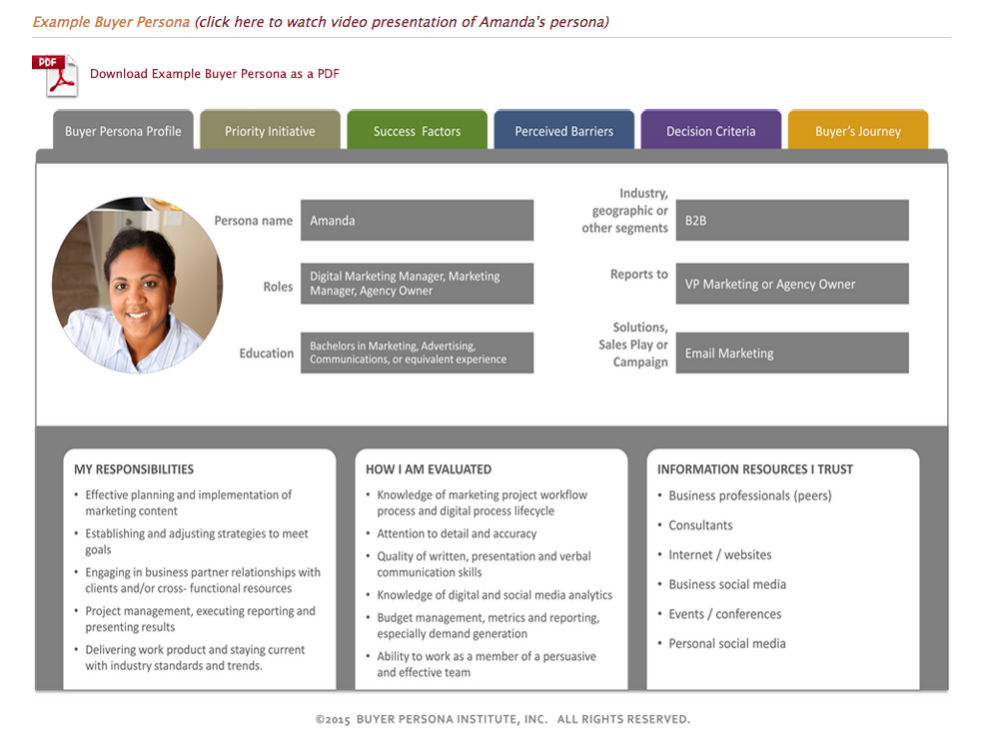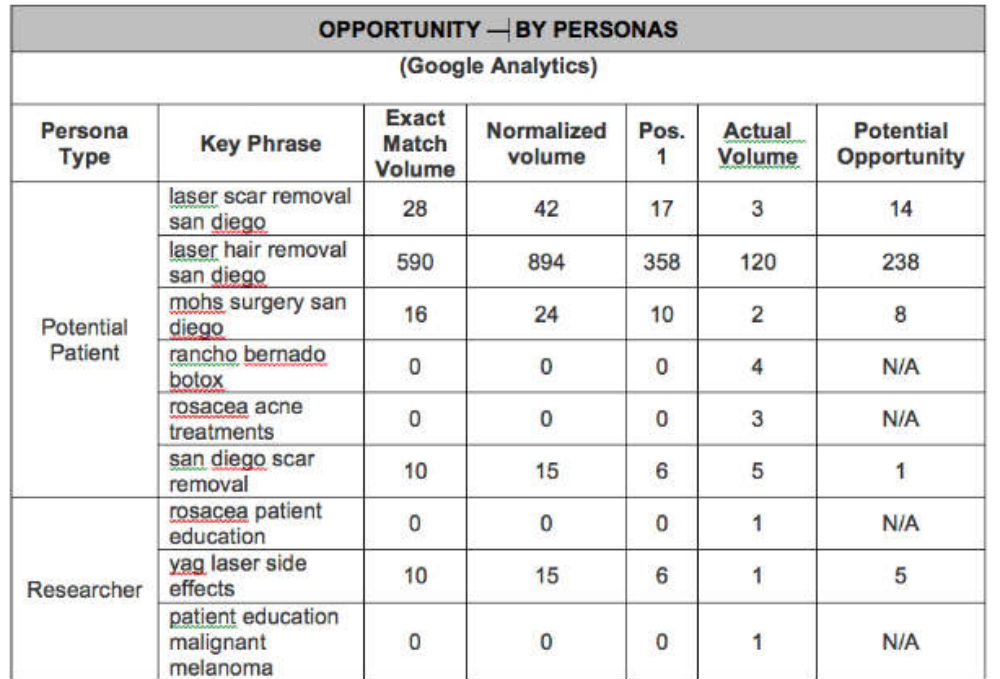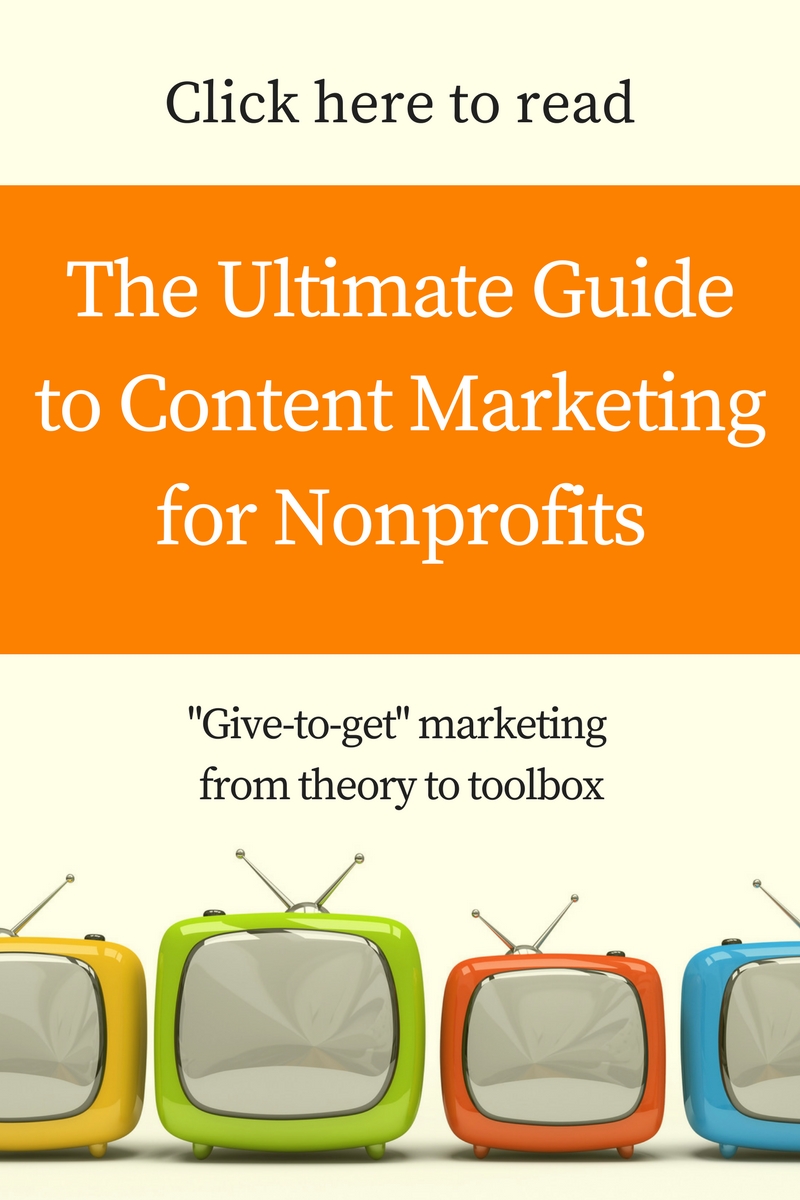Your customers are characters in the story of your business, and buyer personas are the cheat sheets you need to remember their values and the content they are interested in.
A buyer persona is a single character profile that represents a segment of customers you are targeting. New smart marketing tools mean buyer personas can be based on data, research and interviews from real consumers in that segment, but the marketer often uses a bit of imagination to flesh out the character. This person could be Elise, the young manager who wants fast results and reads everything on her phone, or maybe Marcus, an older executive with fierce loyalty to his favorite brands and plenty of hobbies.
Creating these characters sounds time consuming because, well, it is. A vexing problem in marketing is that smart strategy really requires a tool like buyer personas to keep focused, so everyone knows they need to develop them, but very few ever actually do.
[tweetthis]Everyone knows they need to develop buyer personas, but very few ever actually do.[/tweetthis]
That’s why we are proposing the concept of the Minimum Viable Buyer Persona. Like the Minimum Viable Product concept well-known in the Lean Startup movement, the result of a Minimum Viable Buyer Persona isn’t perfect, so you do need to keep iterating on it to improve it.
But the MVBP has the advantage of being doable. You can “ship” in a short time, get some momentum going and be in a much better strategic position with your marketing in a short time.
Related reading: A Definition of Content Marketing Based on What You Can Do For Others
If you want to produce great buyer personas without spending the weeks or months it takes some companies to develop them, follow these steps. Your characters will never know you took shortcuts.
Do your personas before producing more content
Making great buyer personas will allow you to better target and craft your content. It’s best to make the personas before you start your content marketing.
Meanwhile, back in reality . . . .
If you’ve already published a lot of content, give yourself a break. Don’t let the sunk cost fallacy keep you from moving forward. Make up your mind to start working on buyer personas from now on and try to tweak existing content to be more relevant to the characters you create.
[tweetthis]Don’t let the sunk cost fallacy keep you from starting your buyer personas.[/tweetthis]
Talk to some of your followers
A full-bore process to develop buyer personas would involve a highly skilled research firm and a series of carefully scripted interviews and focus groups. The goal of a project is to get enough data to make the findings statistically reliable, mixed with the voices, examples and deeper explanation that talking to real individuals provides.
So, how can you hack together something in just a couple weeks? We recommend limiting yourself to quick and dirty surveys for now. If you have more money than time, you can offer gift cards or a month free of your product to people who complete the survey. Some of the places you can distribute it include your existing newsletter list and the feeds on your Twitter account and other social profiles.
You want to mix questions on demographic data and on their values, goals and concerns with lots of room for comment. The more you can hear their voices, the better off you’ll be.
Also, make sure to ask if they would be interested in participating in a telephone interview. Even if you don’t have time to go that in-depth now, those contacts will be helpful later when you work on improving your Minimum Viable Buyer Persona.
Some of the tools you can use include:
You can also talk to members of your sales and customer service teams. If time allows, invite all of your staff to weigh in.
Use SEO data and more
If you’ve already been gathering SEO data, it’s time to mine it for your buyer personas. This will give you additional information you can use to make them more specific, according to a helpful lesson by Jey Pandian on the Content Marketing Institute.
For example, looking at the order of keywords will show consumers’ priorities. Employ any other data you’ve been collecting such as social media data. This will help you decide which personas you should most focus on.
Document your impressions
You probably have certain impressions or images of your target customers already. Where did those come from? Wherever it is, it’s useful at this point to actually document the impressions and write down what you are seeing.
One way would be to go to the places where you encounter your customers and start making notes. For example, bring up your Twitter followers and scan their profiles for a few minutes noting what you see. What questions are they asking? What keywords do they tend to use? What do they express enthusiasm about?
Fill in the blanks
There are some things your customer might not tell you. To fill the gaps in your persona, think deeply about the product and your customer’s relationship with it. You can also use what you have and test assumptions based on it. If your customers like X, it probably means they don’t like Y, and perhaps this is useful information. Either way, this is where the imagination comes in.
Fill in the questionnaire for the character
There are a ton of great templates for buyer personas out there, though they can be quite comprehensive, and you may not have the data required to complete many of them.
Filling them out is almost like completing a questionnaire on someone else’s behalf. This is how my buyer would answer these questions. Some of the typical questions they ask are:
- Title of your target customer
- Responsibilities
- Goals and aspirations
- How they are evaluated or measured
- Who they report to
- Who reports to them
- Tools they use
- Their pain points
- Their “buyer resistance” points
- What newspapers they read
- What websites they visit
Take a few minutes to imagine how a typical representative from each of your buyer segments would answer those questions, and you are almost done.
Writing the personas
Now you take all the data and notes, give each persona a name, and craft a few paragraphs that describes them or tells their story. Think of it as like the character description paragraphs in a Cliff Notes summary of a novel.
Buyer personas can have significant variations in structure and length, but the overarching story is always there. Anyone who reads a persona should understand who the character is and what he or she cares about, and they should be able to formulate a content plan that targets them and moves them further along the sales funnel.
Illustrating the personas
Next, each profile should have a headshot to go with it. You might pass this off to a designer on your team, but if you do it yourself, try not to overthink it. Open a stock image site or open up the image section of Google search, and starting typing some of the keywords from each of your profiles. You are looking for a photo you can connect to the profile you wrote — an avatar you can pin above your desk when you are working on articles targeting this customer.
[tweetthis]The key to a Minimum Viable Buyer Persona is not to overthink it.[/tweetthis]
Finally, you synthesize it all on a single page with the key bullet points, the paragraph of description and the picture, all in one reference tool.

- credit: Buyer Persona Institute
Ship, test and iterate
Now you have your Minimum Viable Buyer Personas. Share them around with your content team and use them by comparing them against your content calendar. Is your material targeting these characters? Can you start giving your content more focus on the needs and interests of these personas?
One simple way to test personas is to show them to your customers and ask for feedback. If you segment your blog or newsletter subscribers, you can test the personas one segment at a time. Maybe one persona works better with an unexpected group, which are results you can use to pivot and improve your marketing.
The content itself is a great way of testing the viability of the personas. You can send certain pieces of new and old content to a segment and see what kind of click-through rate you get. You can also lay your cards on the table and say you are testing this content and ask people if the content resonates with them.
Once the characters are “live” and results are coming in, you will probably start to get a steadily clearer sense of your personas. Now it will be time to edit your story and make adjustments. Remember, no one writes perfect first drafts.

Joseph Rauch
Guest Author
Joseph Rauch is a content writer and journalist who plans to publish his novel and use his content marketing skills to ensure it sells.
Follow Us
[nino_social_custom nino-size-64 nino-css3-style-7 nino-social-style-3 nino-align-center nino_social_linkedIn:robertwmcguire nino_social_twitter:robertwmcguire nino_social_social-google:115072345633828765009%2F nino_social_quora:http%3A%2F%2Fwww.quora.com%2FRobert-McGuire-1%2Fanswers nino_social_email:robert%40mcguireeditorial.com]





